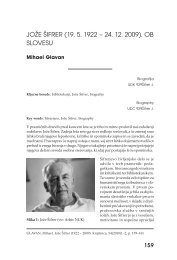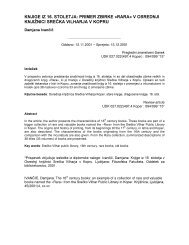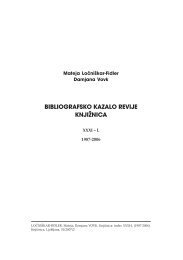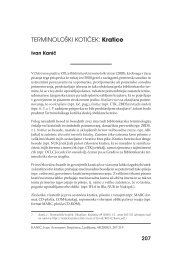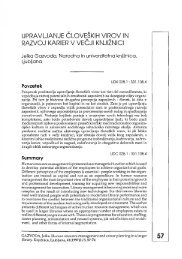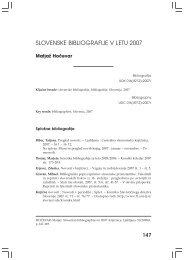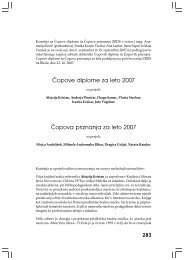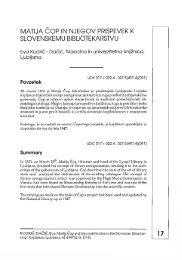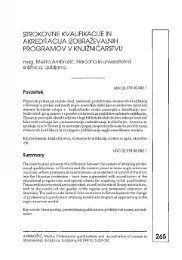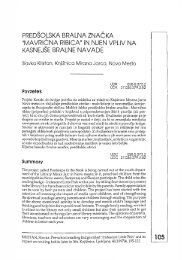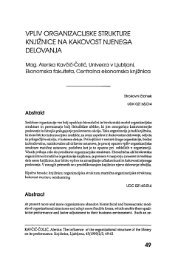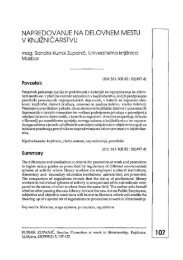the role of children's libraries in developing a ... - Revija Knjižnica
the role of children's libraries in developing a ... - Revija Knjižnica
the role of children's libraries in developing a ... - Revija Knjižnica
Create successful ePaper yourself
Turn your PDF publications into a flip-book with our unique Google optimized e-Paper software.
THE ROLE OF CHILDREN’S LIBRARIES IN<br />
DEVELOPING A MULTICULTURAL<br />
DIALOGUE<br />
Jutta Reusch<br />
Izvleček<br />
Strokovni članek<br />
UDK 027.6-053.2(430.129.751)<br />
UDK 821-93:017/019<br />
Internationale Jugendbiblio<strong>the</strong>k München – mednarodna mlad<strong>in</strong>ska knjižnica v<br />
Münchnu vse od svoje ustanovitve leta 1949 zbira knjige za otroke <strong>in</strong> mlad<strong>in</strong>o v vseh<br />
jezikih <strong>in</strong> je največja tovrstna knjižnica na svetu. Medkulturni dialog vzpodbuja z vrsto<br />
različnih aktivnosti: z izposojo otroške <strong>in</strong> mlad<strong>in</strong>ske literature v 14 različnih jezikih,<br />
s programi zgodnjega opismenjevanja predšolskih otrok v nacionalno mešanih skup<strong>in</strong>ah<br />
<strong>in</strong> programi za šoloobvezne otroke <strong>in</strong> mlad<strong>in</strong>o, s tečaji angleškega jezika, z bogatim<br />
programom razstav <strong>in</strong> s štipendiranjem ustvarjalcev <strong>in</strong> založnikov otroške <strong>in</strong> mlad<strong>in</strong>ske<br />
književnosti ter pedagogov. <strong>Knjižnica</strong> izdaja katalog The White Ravens, ki pr<strong>in</strong>aša<br />
letni izbor najboljše svetovne otroške <strong>in</strong> mlad<strong>in</strong>ske literature <strong>in</strong> je postal referenca<br />
za vse, ki se ukvarjajo z literaturo za ti dve starostni skup<strong>in</strong>i.<br />
Ključne besede: Internationale Jugendbiblio<strong>the</strong>k München, The White Ravens, splošne<br />
knjižnice, mlad<strong>in</strong>ski oddelki, knjižnične zbirke<br />
Abstract<br />
Pr<strong>of</strong>essional article<br />
UDC 027.6-053.2(430.129.751)<br />
UDC 821-93:017/019<br />
Internationale Jungendbiblio<strong>the</strong>k München – International Youth Library <strong>in</strong> Munich<br />
has been collect<strong>in</strong>g books for children and youth <strong>in</strong> all languages s<strong>in</strong>ce its foundation<br />
<strong>in</strong> 1949 and it is <strong>the</strong> biggest library <strong>of</strong> this k<strong>in</strong>d <strong>in</strong> <strong>the</strong> world. The <strong>in</strong>tercultural dialogue<br />
encourages a number <strong>of</strong> different activities: lend<strong>in</strong>g children’s and youth literature <strong>in</strong><br />
REUSCH, Jutta. The <strong>role</strong> <strong>of</strong> children’s <strong>libraries</strong> <strong>in</strong> develop<strong>in</strong>g a multicultural dialogue.<br />
<strong>Knjižnica</strong>, Ljubljana, 53(2009)1-2, p. 209–219<br />
209
<strong>Knjižnica</strong> 53(2009)1-2, 209–219<br />
14 different languages, early literacy programmes for pre-school children <strong>in</strong> nationally<br />
mixed groups and programmes for school children and youth, English language courses,<br />
wide programme <strong>of</strong> exhibitions and scholarships for authors and publishers <strong>of</strong><br />
children’s and youth literature as well as for educators. The library publishes <strong>the</strong> annual<br />
catalogue »The White Ravens«, br<strong>in</strong>g<strong>in</strong>g <strong>the</strong> selection <strong>of</strong> <strong>the</strong> best children’s and youth<br />
literature <strong>in</strong> <strong>the</strong> world. It has turned out to be a reference tool for all deal<strong>in</strong>g with<br />
literature for <strong>the</strong>se two age groups.<br />
Keywords: Internationale Jugendbiblio<strong>the</strong>k München, The White Ravens, public <strong>libraries</strong>,<br />
children’s <strong>libraries</strong>, library collections<br />
1 International Youth Library<br />
The International Youth Library develops <strong>the</strong> multicultural dialogue <strong>in</strong> many ways<br />
i.e. <strong>in</strong> large and small projects as well as <strong>in</strong> <strong>the</strong> library’s everyday work.<br />
Be<strong>in</strong>g <strong>the</strong> largest library for <strong>in</strong>ternational children’s and youth literature <strong>in</strong> <strong>the</strong><br />
world, <strong>the</strong> International Youth Library has <strong>the</strong> mission, from its foundation <strong>in</strong><br />
1949 to <strong>the</strong> present, to build a bridge among children all over <strong>the</strong> world. The Library’s<br />
founder Jella Lepman was conv<strong>in</strong>ced that books for children and young<br />
adults would br<strong>in</strong>g people – especially children – toge<strong>the</strong>r. In Germany destroyed<br />
by <strong>the</strong> Nazi dictatorship and war, she considered children’s literature to be a means<br />
for more justice and peace <strong>in</strong> <strong>the</strong> world. In 1945 she requested for books from<br />
o<strong>the</strong>r countries, exhibited <strong>the</strong>m <strong>in</strong> 1946 and opened <strong>the</strong> International Youth Library<br />
as early as <strong>in</strong> 1949 with a collection <strong>of</strong> 8000 <strong>in</strong>ternational books. Books<br />
open <strong>the</strong> m<strong>in</strong>ds to tolerance, mutual understand<strong>in</strong>g and peaceful <strong>in</strong>teraction <strong>of</strong><br />
people, and books <strong>in</strong> <strong>in</strong>ternational languages give <strong>the</strong> children and young people<br />
<strong>the</strong> opportunity to learn and tra<strong>in</strong> different languages, be<strong>in</strong>g aga<strong>in</strong> a device for<br />
communication and cultural <strong>in</strong>terchange.<br />
At present, <strong>the</strong> International Youth Library’s collection consists <strong>of</strong> about 600,000<br />
<strong>in</strong>ternational children’s and young adult books <strong>in</strong> over 130 languages published<br />
with<strong>in</strong> <strong>the</strong> past 400 years, <strong>in</strong>clud<strong>in</strong>g 80,000 historical books. In addition, <strong>the</strong>re<br />
are nearly 30,000 titles <strong>of</strong> <strong>in</strong>ternational secondary literature, approximately 250<br />
pr<strong>of</strong>essional periodicals, and 40,000 documents. About 1,000 publishers from<br />
all around <strong>the</strong> world k<strong>in</strong>dly donate sample copies <strong>of</strong> <strong>the</strong>ir newly published titles<br />
to <strong>the</strong> library each year.<br />
Nowadays Library’s ma<strong>in</strong> tasks are collection management, catalogu<strong>in</strong>g, access<br />
to and promotion <strong>of</strong> books. The library also ma<strong>in</strong>ta<strong>in</strong>s <strong>the</strong> <strong>in</strong>ternational study<br />
library, <strong>in</strong>ternational children’s library and <strong>the</strong> read<strong>in</strong>g museums.<br />
210
Reusch, J. The <strong>role</strong> <strong>of</strong> children’s <strong>libraries</strong> <strong>in</strong> develop<strong>in</strong>g a multicultural dialogue<br />
Basically all <strong>of</strong> <strong>the</strong>se activities support <strong>the</strong> idea <strong>of</strong> build<strong>in</strong>g bridges between children<br />
and adults. On <strong>the</strong> basis <strong>of</strong> <strong>in</strong>ternational collections, all <strong>of</strong> <strong>the</strong> mediation<br />
activities <strong>of</strong> <strong>the</strong> IYL contribute to <strong>the</strong> <strong>in</strong>tercultural dialogue. An overview <strong>of</strong> International<br />
Youth Library’s various activities <strong>in</strong> develop<strong>in</strong>g multicultural dialogue<br />
is described.<br />
2 “Early literacy” read<strong>in</strong>g promotion programme<br />
for mixed pre-school groups <strong>of</strong> immigrant and<br />
German children<br />
The model project <strong>of</strong> early literacy promotion is <strong>in</strong>iciated by <strong>the</strong> International<br />
Youth Library and f<strong>in</strong>anced by Ellis-Kaut-Foundation for a period <strong>of</strong> one year at<br />
first. It is <strong>in</strong> l<strong>in</strong>e with <strong>the</strong> Bavarian educational plan for pre-schools and it is based<br />
on <strong>the</strong> consensus that besides <strong>the</strong> general media competency read<strong>in</strong>g is one <strong>of</strong> <strong>the</strong><br />
most important cultural techniques that can be taught even <strong>in</strong> a pre-school period<br />
ei<strong>the</strong>r by parents or by <strong>libraries</strong>. In cooperation with <strong>the</strong> International Youth<br />
Library a freelance pedagogue <strong>of</strong>fers courses for pre-school children. Three preschool<br />
classes from different parts <strong>of</strong> Munich attended by pupils <strong>of</strong> different nationalities,<br />
i.e. immigrant children with and language problems participate <strong>in</strong> this<br />
project.<br />
The work <strong>in</strong> <strong>the</strong>se groups is <strong>the</strong> follow<strong>in</strong>g: children are first led <strong>in</strong>to <strong>the</strong> book<br />
store <strong>of</strong> <strong>the</strong> International Youth Library located under <strong>the</strong> castle’s courtyard. They<br />
are asked to stand <strong>in</strong> l<strong>in</strong>e <strong>in</strong> front <strong>of</strong> a book shelf just to see how many children<br />
would take to make one meter <strong>of</strong> a shelf. Children can also touch <strong>the</strong> books, which<br />
<strong>the</strong>y f<strong>in</strong>d very excit<strong>in</strong>g.<br />
After <strong>the</strong> first contact <strong>the</strong>y make excursions to <strong>the</strong> read<strong>in</strong>g museums display<strong>in</strong>g<br />
books illustrated by B<strong>in</strong>ette Schroeder and written by Erich Kästner, James Kruess<br />
and Michael Ende. After hav<strong>in</strong>g discovered i.e. <strong>the</strong> tortoise “Tranquilla Trampeltreu”,<br />
a figure out <strong>of</strong> Michael Ende’s books, <strong>the</strong> group visited <strong>the</strong> zoo to watch<br />
tortoises. Inspired by a book illustrated by B<strong>in</strong>ette Schroeder, <strong>the</strong>y danced a thunderbird<br />
dance.<br />
Ano<strong>the</strong>r important part <strong>of</strong> <strong>the</strong> project consists <strong>of</strong> <strong>in</strong>vit<strong>in</strong>g parents <strong>of</strong> pre school<br />
children to <strong>the</strong> library. The aim is to <strong>in</strong>spire <strong>the</strong> parents, especially those with<br />
different cultural or religious backgrounds, to talk with <strong>the</strong>ir children about <strong>the</strong>ir<br />
excursions and <strong>the</strong> books <strong>the</strong>y have discovered, and to read to <strong>the</strong>m. It is important<br />
to adapt <strong>the</strong> programmes to <strong>the</strong> needs <strong>of</strong> <strong>the</strong> children so <strong>the</strong>y can discover<br />
and feel <strong>the</strong>ir environment. Thus, children are be<strong>in</strong>g tra<strong>in</strong>ed for a still and quiet<br />
211
<strong>Knjižnica</strong> 53(2009)1-2, 209–219<br />
read<strong>in</strong>g process. This joyful experience will be associated to books when children<br />
learn to read.<br />
3 Activities <strong>of</strong> <strong>the</strong> public children’s library<br />
The children’s lend<strong>in</strong>g library <strong>of</strong>fers 25,000 books <strong>in</strong> thirteen languages and a<br />
media collection for children and teenagers. The use <strong>of</strong> <strong>the</strong> children’s lend<strong>in</strong>g library<br />
is public and free <strong>of</strong> charge. In addition to about 12,000 books <strong>in</strong> German,<br />
users can browse books <strong>in</strong> <strong>the</strong> follow<strong>in</strong>g languages: Dutch, English, French, Greek,<br />
Italian, Japanese, Persian, Portuguese, Russian, Swedish, Spanish, and Turkish.<br />
Moreover, <strong>the</strong> library <strong>of</strong>fers an <strong>in</strong>terest<strong>in</strong>g and varied programme <strong>of</strong> activities for<br />
children – naturally focus<strong>in</strong>g on books and stories from around <strong>the</strong> world:<br />
In English courses children learn <strong>the</strong> English language <strong>in</strong> a playful way <strong>in</strong> a context<br />
different from school.<br />
The Children’s Library regularly <strong>in</strong>vites a story teller who <strong>in</strong> a lively and dramatical<br />
way tells fairy tales and o<strong>the</strong>r stories. In her <strong>in</strong>teractive concept she <strong>in</strong>spires<br />
children to participate <strong>in</strong> recall<strong>in</strong>g <strong>the</strong> tales.<br />
We have just started to br<strong>in</strong>g to life a read<strong>in</strong>g club for small children. The librarian<br />
suggests some titles for read<strong>in</strong>g at home, and once every second week children<br />
can talk about <strong>the</strong>ir books and recommend <strong>the</strong>m to <strong>the</strong> o<strong>the</strong>rs.<br />
For Easter, Christmas, Santa Lucia, family feasts and o<strong>the</strong>r occasions, children<br />
make handicrafts, for example lighthouses with candles that <strong>the</strong>y let swim on <strong>the</strong><br />
lake <strong>in</strong> front <strong>of</strong> <strong>the</strong> castle <strong>of</strong> Santa Lucia. This non verbal way <strong>of</strong> communication<br />
br<strong>in</strong>gs toge<strong>the</strong>r children <strong>of</strong> different nationalities.<br />
Toge<strong>the</strong>r with an Australian public Children’s library, we participate <strong>in</strong> a project<br />
called “travell<strong>in</strong>g pants”. The idea is derived from Ann Brashares girl’s book “The<br />
sisterhood <strong>of</strong> <strong>the</strong> travell<strong>in</strong>g pants”, <strong>in</strong> which three girls who are friends travel to<br />
different places dur<strong>in</strong>g <strong>the</strong>ir holidays and send a pair <strong>of</strong> jeans to each o<strong>the</strong>r to tell<br />
<strong>the</strong> story <strong>of</strong> <strong>the</strong>ir holidays. In our case <strong>of</strong> cooperation, <strong>the</strong> Australian library sends<br />
a pair <strong>of</strong> jeans all over <strong>the</strong> world and to <strong>the</strong> International Youth Library, too. Thus,<br />
children may reveal <strong>the</strong>ir own life experience by writ<strong>in</strong>g or stick<strong>in</strong>g on <strong>the</strong> jeans.<br />
This <strong>in</strong>tercultural dialogue jo<strong>in</strong>s <strong>the</strong> cont<strong>in</strong>ents and consists not only <strong>of</strong> language<br />
but also <strong>of</strong> all sorts <strong>of</strong> signs.<br />
212
Reusch, J. The <strong>role</strong> <strong>of</strong> children’s <strong>libraries</strong> <strong>in</strong> develop<strong>in</strong>g a multicultural dialogue<br />
4 Exhibitions <strong>in</strong> <strong>the</strong> International Youth Library<br />
Draw<strong>in</strong>g upon its unique collection, <strong>the</strong> International Youth Library mounts a<br />
variety <strong>of</strong> exhibitions on a wide range <strong>of</strong> <strong>the</strong>mes every year <strong>in</strong> <strong>the</strong> halls <strong>of</strong> Blutenburg<br />
Castle <strong>in</strong>clud<strong>in</strong>g orig<strong>in</strong>al works <strong>of</strong> illustrators, representative surveys <strong>of</strong><br />
<strong>the</strong> children’s literature <strong>of</strong> different countries or cultures, and current or historical<br />
aspects <strong>of</strong> children’s literature. The exhibitions, which are designed both for<br />
adults and children, are usually accompanied by a list <strong>of</strong> recommended books or<br />
a catalogue. For most <strong>of</strong> <strong>the</strong>m, <strong>the</strong> library also <strong>of</strong>fers a special programme <strong>of</strong> activities<br />
for school classes.<br />
In <strong>the</strong> range <strong>of</strong> International Youth Library’s exhibitions <strong>the</strong>re are book exhibitions<br />
present<strong>in</strong>g its <strong>in</strong>ternational collections and <strong>in</strong>ternational illustrators’ exhibitions.<br />
Illustrations are <strong>the</strong> expression <strong>of</strong> a specific culture on one hand and on<br />
<strong>the</strong> o<strong>the</strong>r hand a pictural “language” which can be understood by any culture <strong>in</strong><br />
<strong>the</strong> world.<br />
One <strong>of</strong> this year’s exhibitions was called “Paradiesische Aussichten” - “Visions<br />
<strong>of</strong> Paradise”. Its aim was to present children’s and young adult’s books deal<strong>in</strong>g<br />
with religious conflicts result<strong>in</strong>g from <strong>the</strong> coexistence <strong>of</strong> Muslim and Christian<br />
children, young adults and families <strong>in</strong> multicultural Germany occurr<strong>in</strong>g especially<br />
<strong>in</strong> <strong>the</strong> cities and at school.<br />
On <strong>the</strong> occasion <strong>of</strong> this exhibition we <strong>in</strong>vited a writer and a politician Azouz Begag<br />
and a writer Aigen Sibel Celik. Azouz Begag, s<strong>in</strong>g<strong>in</strong>g and act<strong>in</strong>g, told <strong>the</strong> story <strong>of</strong><br />
his family who had emigrated from Algeria to Paris where he was born <strong>in</strong> an<br />
immigrants’ suburb. Thanks to his fa<strong>the</strong>r he learned read<strong>in</strong>g, went to school, studied<br />
and even became <strong>the</strong> m<strong>in</strong>ister <strong>of</strong> equality <strong>of</strong> chances some years ago.<br />
Aigen Sibel Celik read out <strong>of</strong> her novel “Seidenhaar”. Its ma<strong>in</strong> topic is wear<strong>in</strong>g<br />
<strong>the</strong> veil. We <strong>in</strong>vited an elementary school class at <strong>the</strong> age <strong>of</strong> about 14. Some <strong>of</strong> <strong>the</strong><br />
listeners were wear<strong>in</strong>g <strong>the</strong> veil <strong>the</strong>mselves, and afterwards a lively and animated<br />
discussion started about wear<strong>in</strong>g <strong>the</strong> veil for religious reasons <strong>in</strong> a German school.<br />
The direct <strong>in</strong>tercultural discussion was provoked and we have <strong>the</strong> impression<br />
that it will be cont<strong>in</strong>ued not only at school but at home, too.<br />
In 2002 <strong>the</strong>re was an exhibition present<strong>in</strong>g children’s literature from Canada <strong>in</strong><br />
English, French and translations to make German readers acqa<strong>in</strong>ted with <strong>the</strong> wide<br />
variety <strong>of</strong> <strong>the</strong> lively Canadian children’s literature scene. Books by Brian Doyle,<br />
Richard Van Camp or Polly Horvath and illustrations by Pierre Pratt or Michčle<br />
Lemieux were presented. Canada’s landscape and children’s everyday life were<br />
presented, too.<br />
213
<strong>Knjižnica</strong> 53(2009)1-2, 209–219<br />
Annual exhibitions focus on <strong>the</strong>mes and topics <strong>of</strong> <strong>in</strong>terest to many countries and<br />
parts <strong>of</strong> <strong>the</strong> world i.e. fairy tales <strong>of</strong> <strong>the</strong> Grimm bro<strong>the</strong>rs <strong>in</strong> <strong>the</strong> year 2007 or Rob<strong>in</strong>son<br />
Crusoe and Rob<strong>in</strong>son stories this year. Rob<strong>in</strong>son Crusoe is <strong>the</strong> epitome <strong>of</strong><br />
a travell<strong>in</strong>g and cosmopolitan character explor<strong>in</strong>g new parts <strong>of</strong> <strong>the</strong> world and<br />
mak<strong>in</strong>g contact with representatives <strong>of</strong> o<strong>the</strong>r cultures.<br />
5 Travell<strong>in</strong>g Exhibitions tour<strong>in</strong>g <strong>the</strong> world<br />
Some <strong>of</strong> <strong>the</strong> International Youth Library’s exhibitions are also available as travell<strong>in</strong>g<br />
exhibitions for presentations <strong>in</strong> public <strong>libraries</strong>, schools, and o<strong>the</strong>r <strong>in</strong>stitutions<br />
all over <strong>the</strong> world. One <strong>of</strong> its most successful travell<strong>in</strong>g exhibitions to<br />
date is “Hello, Dear Enemy!” a selection <strong>of</strong> <strong>in</strong>ternational picture books on peace<br />
and tolerance. It has been travell<strong>in</strong>g around India, Japan, Europe, and <strong>the</strong> USA.<br />
The updated exhibition, <strong>the</strong> new catalogue was published <strong>in</strong> 2006, presents 80<br />
titles from 20 countries accompanied by 20 annotations and picture panels. In<br />
1998 it went to <strong>the</strong> IBBY congress on peace and tolerance <strong>in</strong> New Delhi. Peace is<br />
one <strong>of</strong> <strong>the</strong> ma<strong>in</strong> messages <strong>of</strong> <strong>the</strong>se exhibitions, go<strong>in</strong>g aga<strong>in</strong> back to Jella Lepmans<br />
ideas:<br />
“Why were human be<strong>in</strong>gs still not capable <strong>of</strong> carry<strong>in</strong>g on <strong>the</strong>ir affairs <strong>of</strong> state<br />
<strong>in</strong>telligently? I wondered. Here this beautiful planet called earth belonged to <strong>the</strong>m,<br />
and what did <strong>the</strong>y do? War! Aga<strong>in</strong> and aga<strong>in</strong> children were <strong>in</strong> danger <strong>of</strong> be<strong>in</strong>g killed<br />
<strong>in</strong> wars. Maybe it would be better to let <strong>the</strong> animals <strong>of</strong> <strong>the</strong> world have a stab at<br />
govern<strong>in</strong>g, match<strong>in</strong>g <strong>the</strong>ir <strong>in</strong>st<strong>in</strong>ct aga<strong>in</strong>st human reason.” (Jella Lepman: Die<br />
K<strong>in</strong>derbuchbrücke)<br />
The exhibition project “Hello, dear Enemy” has been pursu<strong>in</strong>g this idea s<strong>in</strong>ce 2006<br />
to support parents, teachers, and librarians <strong>in</strong> <strong>the</strong>ir mediat<strong>in</strong>g efforts. Most <strong>of</strong> <strong>the</strong><br />
books <strong>in</strong> this selection deal with <strong>the</strong> pre conditions <strong>of</strong> war: <strong>in</strong>tolerance, xenophobia,<br />
prejudice, abuse <strong>of</strong> power, oppression, and violence aga<strong>in</strong>st people and property.<br />
Many <strong>of</strong> <strong>the</strong> stories convey <strong>the</strong> message that tolerance is <strong>the</strong> basis for peaceful<br />
coexistence with <strong>the</strong> worldwide community <strong>of</strong> people and cultures and that<br />
solution to conflicts can be found through reason and reflection. Tolerance is far<br />
more than a frame <strong>of</strong> m<strong>in</strong>d: it is social behaviour that must be learned, tra<strong>in</strong>ed<br />
and embedded <strong>in</strong> social reality.<br />
Ano<strong>the</strong>r successful travell<strong>in</strong>g exhibition is entitled “Children between Worlds”:<br />
In a world divided between <strong>the</strong> poor and <strong>the</strong> rich, between north and south, between<br />
those who live <strong>in</strong> totalitarian states, and those who live <strong>in</strong> democracies,<br />
between those who have work, and those who do not, books can serve as mediators,<br />
because <strong>the</strong>y are <strong>the</strong>mselves part <strong>of</strong> <strong>the</strong> dialogue among cultures.<br />
214
Reusch, J. The <strong>role</strong> <strong>of</strong> children’s <strong>libraries</strong> <strong>in</strong> develop<strong>in</strong>g a multicultural dialogue<br />
Most <strong>of</strong> <strong>the</strong>se exhibitions are accompanied by publications <strong>in</strong> English and German.<br />
The exhibition catalogues outl<strong>in</strong>e <strong>the</strong> contents and <strong>the</strong> aims <strong>of</strong> <strong>the</strong> exhibitions<br />
and <strong>of</strong>fer bibliographic data comb<strong>in</strong>ed with picture panels <strong>of</strong> <strong>the</strong> presented<br />
books and <strong>in</strong>form about <strong>the</strong>ir language, contents and didactical value.<br />
6 Programmes for School Classes<br />
S<strong>in</strong>ce <strong>the</strong> beg<strong>in</strong>n<strong>in</strong>g <strong>of</strong> <strong>the</strong> 1990ies, <strong>the</strong> International Youth Library has <strong>in</strong>troduced<br />
programmes for school classes to build a third place for children (besides family<br />
and schools). They can explore books and acquire read<strong>in</strong>g competence+. Seven<br />
freelance pedagogues from <strong>the</strong> fields <strong>of</strong> didactics <strong>of</strong> arts, graphics, museums and<br />
literature <strong>of</strong>fer guided tours, workshops and read<strong>in</strong>g events with authors.<br />
In <strong>the</strong> guided tours school classes are lead through <strong>the</strong> library and <strong>the</strong> castle where<br />
<strong>the</strong>y learn about <strong>the</strong> history, <strong>the</strong> collections and <strong>the</strong> aims <strong>of</strong> <strong>the</strong> International Youth<br />
Library. As an accompany<strong>in</strong>g effect, children get <strong>the</strong> nonverbal message that a<br />
library can be a place full <strong>of</strong> ideas <strong>of</strong> adventures, history and creativity.<br />
At each workshop one author or illustrator is presented: The pupils get to know<br />
his or her books and create an own work <strong>of</strong> art or text <strong>in</strong>spired by <strong>the</strong>ir perception.<br />
Smaller children and children with language difficulties are guided to learn<br />
<strong>in</strong> a playful way to discover books and pictures. One example <strong>of</strong> a playful approach<br />
can be a card game accompany<strong>in</strong>g an illustration’s exhibition: Children<br />
draw a card illustrat<strong>in</strong>g <strong>the</strong> text and <strong>the</strong>y pa<strong>in</strong>t <strong>the</strong> illustration or <strong>the</strong> o<strong>the</strong>r way<br />
round: <strong>the</strong>y draw a picture card and write a text associated with this picture.<br />
In addition, our pedagogues visit schools to present a selection <strong>of</strong> books out <strong>of</strong><br />
our travell<strong>in</strong>g exhibitions. They may be accompanied by <strong>in</strong>ternational book illustrators<br />
who participate <strong>in</strong> art workshops. A third <strong>of</strong>fer for schools is a workshop<br />
on <strong>the</strong> topic <strong>of</strong> children’s rights.<br />
A very special school class programme has been developed for young adults from<br />
<strong>the</strong> secondary school <strong>in</strong> cooperation with <strong>the</strong> memorial <strong>in</strong>stitution <strong>of</strong> <strong>the</strong> concentration<br />
camp Dachau (<strong>in</strong> <strong>the</strong> neighbourhood <strong>of</strong> International Youth Library’s “book<br />
castle”): Guided by pedagogues school classes visit <strong>the</strong> concentration camp memorial<br />
and talk and write about this experience.<br />
The German history <strong>of</strong> <strong>the</strong> Nazi-regime is <strong>of</strong> great <strong>in</strong>terest to generations who are<br />
not able to understand this period <strong>of</strong> dictatorship unless <strong>the</strong>ir grandparents are<br />
still alive. They have to be <strong>in</strong>troduced didactically. The groups start <strong>in</strong> <strong>the</strong> Dachau<br />
memorial where <strong>the</strong>y are <strong>in</strong>troduced to <strong>the</strong> site <strong>of</strong> <strong>the</strong> concentration camp, <strong>the</strong><br />
215
<strong>Knjižnica</strong> 53(2009)1-2, 209–219<br />
build<strong>in</strong>gs, <strong>the</strong> documents like diaries written by <strong>the</strong> prisoners, photographs, personal<br />
objects that rema<strong>in</strong>ed <strong>of</strong> <strong>the</strong> victims. In <strong>the</strong> afternoon, <strong>the</strong> group returns to<br />
<strong>the</strong> International Youth Library to attend a workshop led by a pedagogue. The<br />
pupils are asked to write <strong>the</strong>ir own texts about <strong>the</strong>ir thoughts and experiences.<br />
One way <strong>of</strong> deal<strong>in</strong>g with <strong>the</strong> topic is <strong>the</strong> follow<strong>in</strong>g: young people are proposed to<br />
write a fictive letter home from <strong>the</strong> perspective <strong>of</strong> a concentration camp prisoner.<br />
So <strong>the</strong> library becomes an important place for creative learn<strong>in</strong>g.<br />
Last year, a group <strong>of</strong> American university teachers and students participated <strong>in</strong><br />
this programme. In addition, Mirjam Pressler read <strong>the</strong>m parts <strong>of</strong> her novel “Malka<br />
Mai”, deal<strong>in</strong>g with a Jewish girl’s fate dur<strong>in</strong>g <strong>the</strong> Second World War <strong>in</strong> Poland.<br />
This workshop also contributes to <strong>the</strong> <strong>in</strong>tercultural dialogue, not only between<br />
present and past, but also between different countries.<br />
7 International Fellowship Programmes<br />
Researchers, authors, illustrators, publishers, editors, teachers, pedagogues from<br />
all around <strong>the</strong> world can apply to <strong>the</strong> International Youth Library’s fellowship<br />
programme and work for <strong>in</strong> <strong>the</strong> research library up to three months, prepare <strong>the</strong>ir<br />
publications and <strong>the</strong>ir curricula, f<strong>in</strong>d foreign books to translate <strong>the</strong>m <strong>in</strong>to <strong>the</strong>ir<br />
mo<strong>the</strong>r tongue or to publish <strong>the</strong>m <strong>in</strong> <strong>the</strong>ir countries <strong>of</strong> orig<strong>in</strong> etc. Every year about<br />
15 guests from all around <strong>the</strong> world are <strong>of</strong>fered a research fellowship for a period<br />
<strong>of</strong> up to three months. They visit <strong>the</strong> International Youth Library to work on and/<br />
or complete <strong>the</strong>ir own specific scientific research project or study more general<br />
questions on <strong>in</strong>ternational children’s literature, especially projects that would<br />
be difficult to tackle anywhere else. With <strong>the</strong>ir special knowledge and language<br />
skills, <strong>the</strong>se visitors also assist <strong>the</strong> library <strong>in</strong> develop<strong>in</strong>g <strong>the</strong> children’s literature<br />
collections from <strong>the</strong>ir home countries and help mak<strong>in</strong>g new contacts <strong>in</strong> <strong>the</strong> field<br />
<strong>of</strong> children’s literature all over <strong>the</strong> world.<br />
In round tables <strong>the</strong>y present <strong>the</strong>ir work<strong>in</strong>g fields like for <strong>in</strong>stance children’s books<br />
deal<strong>in</strong>g with death, <strong>the</strong> aes<strong>the</strong>tics and function <strong>of</strong> playbooks, <strong>the</strong> image <strong>of</strong> childhood<br />
<strong>in</strong> children’s books etc., so <strong>the</strong> library staff is always <strong>in</strong>formed about <strong>in</strong>ternational<br />
research topics and literature <strong>in</strong> this field.<br />
The fellowship programme is f<strong>in</strong>anced by <strong>the</strong> Auswärtiges Amt der Bundesrepublik<br />
Deutschland (Foreign M<strong>in</strong>istry <strong>of</strong> <strong>the</strong> Federal Republic <strong>of</strong> Germany).<br />
A similar form <strong>of</strong> cooperation is <strong>the</strong> fellowship programme f<strong>in</strong>anced by <strong>the</strong> Japanese<br />
edit<strong>in</strong>g house Kodansha <strong>in</strong> order to f<strong>in</strong>d <strong>in</strong>ternational children’s books to<br />
be translated <strong>in</strong>to Japanese and published <strong>in</strong> Japan. In 2008 a lector <strong>of</strong> Kodansha<br />
216
Reusch, J. The <strong>role</strong> <strong>of</strong> children’s <strong>libraries</strong> <strong>in</strong> develop<strong>in</strong>g a multicultural dialogue<br />
worked on <strong>the</strong> selection <strong>of</strong> <strong>in</strong>ternational goodnight stories for children that could<br />
be published <strong>in</strong> Japan.<br />
There is ano<strong>the</strong>r fellowship cooperation with an US Library School. In <strong>the</strong> United<br />
Stated <strong>the</strong>re is a faculty <strong>of</strong> children’s and young adult’s literature <strong>in</strong> almost every<br />
college or university teach<strong>in</strong>g teachers or librarians. For three years, groups <strong>of</strong><br />
library science students came from <strong>the</strong> Appalachian State University <strong>in</strong> North<br />
Carol<strong>in</strong>a for four week research courses. They took <strong>the</strong> opportunity to learn about<br />
<strong>in</strong>ternational C<strong>in</strong>derella stories, about Dutch pa<strong>in</strong>ters <strong>in</strong> <strong>the</strong> fiction for children<br />
aged from 9 to 18 years, about <strong>in</strong>ternational picture books on environmental protection.<br />
At no place <strong>in</strong> <strong>the</strong> USA or no o<strong>the</strong>r place <strong>in</strong> <strong>the</strong> world <strong>the</strong>y can f<strong>in</strong>d such<br />
an <strong>in</strong>ternational collection <strong>of</strong> children’s literature to work on various research<br />
projects. The International Youth Library’s study library is an ideal work<strong>in</strong>g place<br />
for fellows, scholars and o<strong>the</strong>r patrons. The reference collection comprises nearly<br />
30,000 volumes <strong>of</strong> <strong>in</strong>ternational secondary literature and about 250 current<br />
pr<strong>of</strong>essional periodicals. It <strong>of</strong>fers its visitors access both to <strong>the</strong> reference collection<br />
and to <strong>the</strong> extensive collections <strong>of</strong> <strong>in</strong>ternational children’s and youth literature,<br />
which also <strong>in</strong>cludes approximately 60,000 historical volumes published<br />
between <strong>the</strong> years 1574 and 1950.<br />
8 Annual publication <strong>of</strong> <strong>the</strong> “White Ravens”<br />
Each year, <strong>the</strong> language specialists (Lektoren) at <strong>the</strong> International Youth Library<br />
select recently published books considered to be especially noteworthy. This<br />
»premium label« is given to books <strong>of</strong> <strong>in</strong>ternational <strong>in</strong>terest that deserve a wider<br />
reception on account <strong>of</strong> <strong>the</strong>ir universal <strong>the</strong>me and/or <strong>the</strong>ir exceptional and <strong>of</strong>ten<br />
<strong>in</strong>novative artistic and literary style and design. The result <strong>of</strong> this selection is <strong>the</strong><br />
annual catalogue “The White Ravens” featur<strong>in</strong>g 250 titles from 40 countries with<br />
annotations <strong>in</strong> English. This selection has ga<strong>in</strong>ed <strong>in</strong>ternational recognition because<br />
it highlights <strong>the</strong> trends <strong>of</strong> contemporary children’s and young adult literature<br />
on an <strong>in</strong>ternational scale. It serves <strong>in</strong>ternationally as a list <strong>of</strong> recommendations<br />
for parents, teachers, and librarians, and <strong>in</strong>spires publish<strong>in</strong>g houses to acquire<br />
translation rights. Public and school <strong>libraries</strong> or <strong>in</strong>ternational bookstores<br />
use <strong>the</strong> catalogue as a basis for mak<strong>in</strong>g <strong>the</strong>ir purchases. S<strong>in</strong>ce 1996, <strong>the</strong> White<br />
Ravens selections have been accessible on <strong>the</strong> website <strong>of</strong> <strong>the</strong> International Youth<br />
Library at www.ijb.de. It is also available <strong>in</strong> <strong>the</strong> International Children’s Digital<br />
Library.<br />
217
<strong>Knjižnica</strong> 53(2009)1-2, 209–219<br />
9 Participation <strong>in</strong> Congresses, <strong>in</strong> <strong>the</strong> Bologna and<br />
Frankfurt book fairs and o<strong>the</strong>r <strong>in</strong>ternational<br />
contacts<br />
S<strong>in</strong>ce it is one <strong>of</strong> <strong>the</strong> International Youth Library’s most important tasks to reach<br />
a great part <strong>of</strong> pr<strong>of</strong>essional audience from many different countries, attend<strong>in</strong>g <strong>the</strong><br />
International Children’s Book Fair <strong>in</strong> Bologna (Italy) every spr<strong>in</strong>g and <strong>the</strong> Frankfurt<br />
Book Fair <strong>in</strong> Germany every autumn is a top priority. On one hand <strong>the</strong> library’s<br />
language specialists <strong>in</strong>form Book Fair visitors about <strong>the</strong>ir work and <strong>in</strong>troduce<br />
<strong>the</strong>m to <strong>the</strong> library’s activities and its unique collection; on <strong>the</strong> o<strong>the</strong>r hand,<br />
<strong>the</strong>y seize <strong>the</strong> opportunity to learn about <strong>the</strong> most recent trends and developments<br />
with<strong>in</strong> <strong>the</strong>ir language areas and make and renew contact with children’s literature<br />
pr<strong>of</strong>essionals. Quite frequently, <strong>the</strong>se conversations lead to first ideas for<br />
new exhibitions and projects.<br />
Whenever <strong>the</strong>re is an opportunity, <strong>the</strong> International Youth Library participates <strong>in</strong><br />
<strong>the</strong> IBBY-Congress. The International Board on Books for Young People (IBBY) is<br />
a non-pr<strong>of</strong>it organization which represents an <strong>in</strong>ternational network <strong>of</strong> people<br />
from all over <strong>the</strong> world who are committed to br<strong>in</strong>g<strong>in</strong>g books and children toge<strong>the</strong>r.<br />
IBBY was founded <strong>in</strong> 1953 <strong>in</strong> Zürich, soon after <strong>the</strong> International Youth<br />
Library, by Jella Lepman.<br />
10 Activities <strong>of</strong> <strong>the</strong> language specialists<br />
The language sections serve as a l<strong>in</strong>k between <strong>the</strong> International Youth Library and<br />
publishers and o<strong>the</strong>r book people worldwide.<br />
The work <strong>of</strong> <strong>the</strong> “Lektoren” (language specialists) ensures that <strong>the</strong> library’s unique<br />
archival collection is cont<strong>in</strong>uously expanded and improved. It is <strong>the</strong>ir task to get<br />
<strong>in</strong> touch and keep contact with <strong>the</strong> publishers and <strong>in</strong>stitutions <strong>of</strong> “<strong>the</strong>ir” countries,<br />
to closely follow <strong>the</strong> development and recent trends <strong>of</strong> <strong>the</strong> children’s book<br />
production <strong>of</strong> <strong>the</strong> respective language areas, and to request books for <strong>the</strong> collection<br />
<strong>of</strong> <strong>the</strong> International Youth Library.<br />
The language specialists access <strong>the</strong> <strong>in</strong>com<strong>in</strong>g book titles, provide subject head<strong>in</strong>gs,<br />
compile bibliographies for exhibitions, and write articles and reviews for<br />
<strong>the</strong> library’s recommendation lists and o<strong>the</strong>r publications. At present, <strong>the</strong> International<br />
Youth Library has language specialists for Dutch, English, French, German,<br />
Hungarian, Italian, Japanese, Persian, Romanian, Turkish and <strong>the</strong> Iberian,<br />
Scand<strong>in</strong>avian and Slavic languages.<br />
218
Reusch, J. The <strong>role</strong> <strong>of</strong> children’s <strong>libraries</strong> <strong>in</strong> develop<strong>in</strong>g a multicultural dialogue<br />
11 Database Projects<br />
Last but not least our librarian projects contribute to <strong>the</strong> <strong>in</strong>tercultural dialogue<br />
on <strong>the</strong> basis <strong>of</strong> library’s unique collections:<br />
As not all <strong>of</strong> <strong>the</strong> International Youth Library’s catalogues are searchable onl<strong>in</strong>e,<br />
conversion projects are planned start<strong>in</strong>g with <strong>the</strong> conversion <strong>of</strong> catalogues from<br />
before <strong>the</strong> year 1993. The aim is to make all <strong>of</strong> <strong>the</strong> International Youth Library’s<br />
collections accessible to <strong>the</strong> worldwide community <strong>of</strong> people <strong>in</strong>terested <strong>in</strong> children’s<br />
and young adult’s literature.<br />
Most <strong>of</strong> International Youth Library’s books catalogued s<strong>in</strong>ce 1993 are provided<br />
with subject head<strong>in</strong>gs, so our collections can be searched worldwide. So far, <strong>the</strong><br />
subject head<strong>in</strong>gs have been given only <strong>in</strong> German. Now we are mak<strong>in</strong>g first steps<br />
towards <strong>the</strong> creation <strong>of</strong> English subject head<strong>in</strong>g lists with <strong>the</strong> idea to <strong>in</strong>clude <strong>the</strong>m<br />
<strong>in</strong>to <strong>the</strong> national subject head<strong>in</strong>gs authority file. The aim is to elim<strong>in</strong>ate <strong>the</strong> language<br />
barrier to achieve a multicultural dialogue between <strong>in</strong>ternational researchers<br />
and <strong>the</strong> Onl<strong>in</strong>e Catalogue <strong>of</strong> <strong>the</strong> International Youth Library.<br />
Literature<br />
1. Lepman, Jella (1999). Die K<strong>in</strong>derbuchbrücke. München.<br />
2. Ledig, Eva-Maria (1988). E<strong>in</strong>e Idee für K<strong>in</strong>der. Die Internationale Jugendbiblio<strong>the</strong>k.<br />
München.<br />
3. The International Youth Library’s website. Dostopno na spletni strani http://<br />
www.ijb.de<br />
Mag. Jutta Reusch, bibliotekarka, je vodja knjižničnih storitev v Die Internationale<br />
Jugendbiblio<strong>the</strong>k v Münchenu.<br />
Naslov: Schloss Blutenburg, 81247 München, Nemčija<br />
Naslov elektronske pošte: JuttaReusch@ijb.de<br />
219



